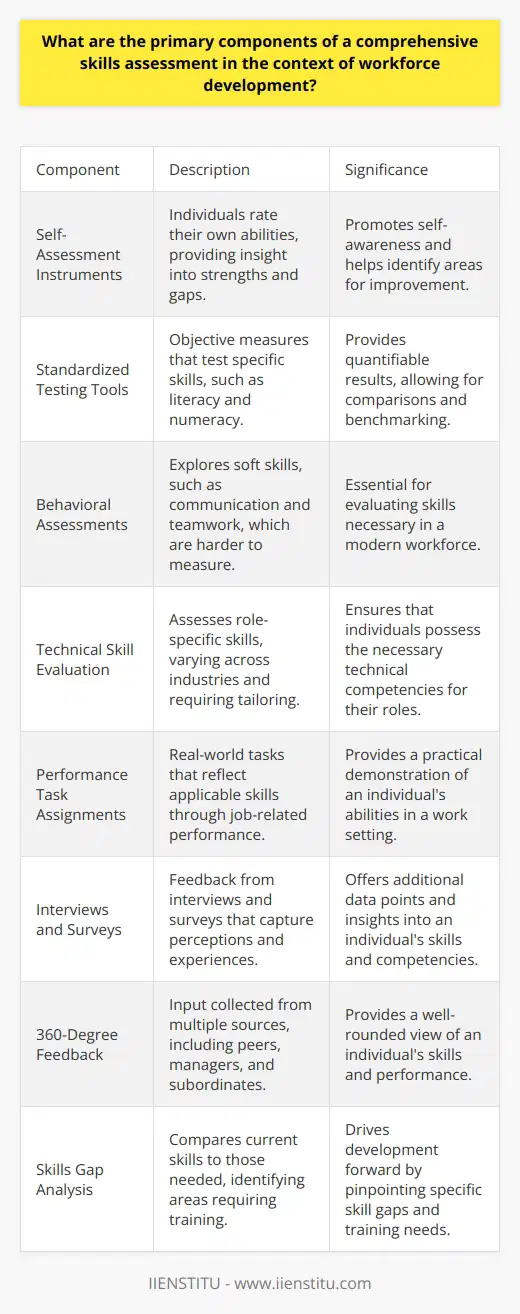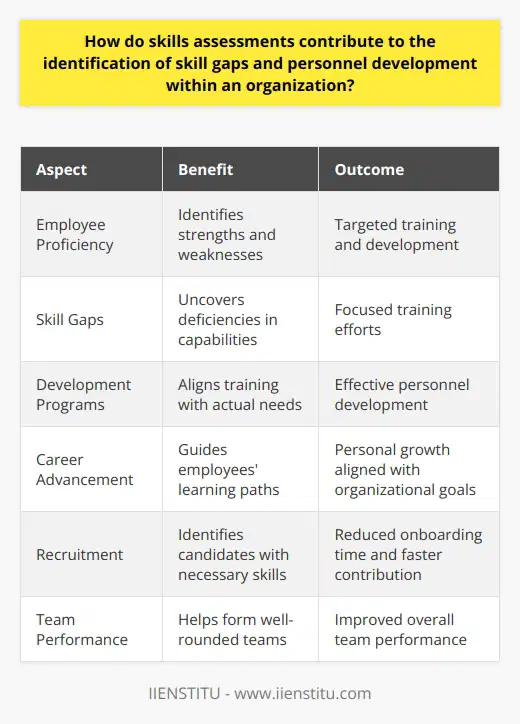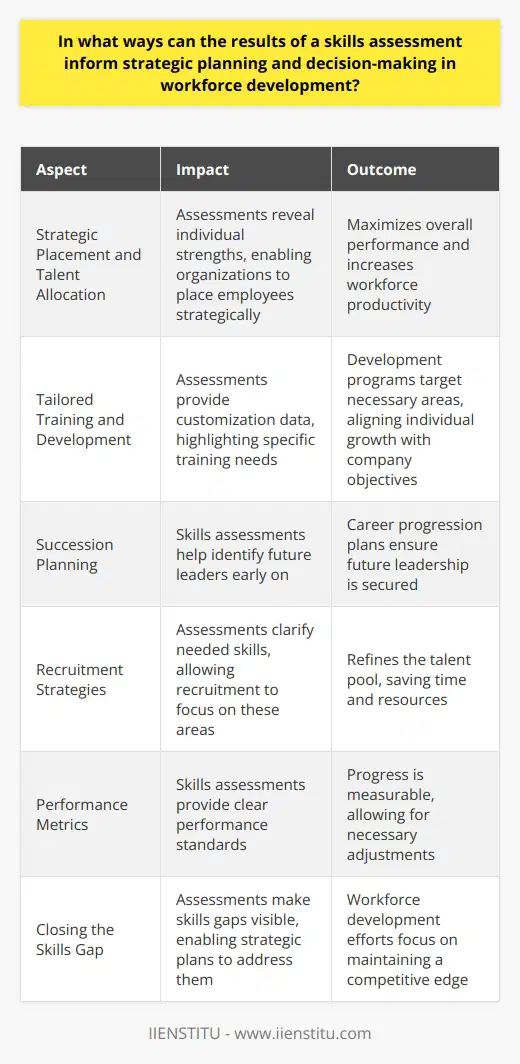
The professional landscape is constantly evolving, with new technologies and methodologies reshaping how we work. In this dynamic environment, workforce development becomes a critical pursuit for organizations aiming to maintain a competitive edge. At the heart of this endeavor lies skills assessment, a tool that serves as the pivot for strategic professional development and talent management.
By rigorously evaluating the skills and competencies of individuals, businesses can align their human resources with organizational goals, create pathways for employee advancement, and sharpen hiring strategies to foster a capable and adaptable workforce. This article delves into the intricacies of skills assessment, its importance across various domains, and its integral role in propelling individuals and organizations towards their zenith of productivity.
You can listen to this text instead of reading it.
What is Skills Assessment?
Detailed Definition
Skills assessment can be described as a systematic approach to identifying and evaluating the abilities, knowledge, and competencies that an individual possesses. For instance, an IT professional might undergo a technical skills assessment to determine their proficiency in various programming languages or their ability to manage network security.
Furthermore, when educators gauge students' understanding of subject material through tests and quizzes, they are conducting a form of skills assessment tailored to an academic environment.
Different Types of Skills to Assess
Skills are often categorized into three primary types: hard skills, soft skills, and job-specific skills. Hard skills refer to technical abilities that are quantifiable and required for specific tasks, like data analysis or machine operation. Soft skills, on the other hand, encompass interpersonal attributes and behaviors such as communication, leadership, and teamwork.
Job-specific skills are the unique set of abilities that are particularly relevant to a certain role or industry. An engineer, for example, might need strong analytical skills and proficiency in CAD software, which are less critical for a human resources specialist.
Hr Literature İnfluence On Organizational Success Strategies
Best Practices For Creating An Accountability Culture İn Human Resources Management
Why is Skills Assessment Important?
Career Development
One of the key functions of skills assessment is to facilitate career development. By providing insights into their strengths and weaknesses, individuals are better equipped to make informed decisions regarding their professional journey. A marketing professional might discover through a skills assessment that they are particularly adept at digital marketing but could improve in market research, guiding them toward specific areas for improvement and training opportunities.
Employee Efficiency
In the context of organizational growth, skills assessment is instrumental in bolstering employee efficiency. Employees who are aware of their skill deficits can pursue online courses with certificates to bridge the gaps, thereby contributing more effectively to their teams and projects. This, in turn, elevates the overall performance of the organization.
Hiring Decisions
Recruiters and hiring managers leverage skills assessment as a critical tool in the selection process. By evaluating candidates against a set of predefined skills, organizations can identify individuals who not only align with the technical requirements of a position but also possess the soft skills necessary for a seamless integration into the company's culture.
Methods of Skills Assessment
Self-Assessment
Individuals who take the initiative to conduct a self-assessment gain a reflective understanding of their capabilities and potential areas for growth. Personal reflection, combined with structured tools like SWOT analysis, can provide a foundational assessment that guides one's professional development trajectory.
Peer Assessment
In many professional settings, peer assessment is leveraged as an avenue for collecting performance-related feedback. Colleagues often have unique insight into an individual's work habits, strengths, and areas of improvement, making peer reviews a valuable component of comprehensive skills assessment.
Expert Assessment
Bringing in specialists or utilizing assessment tools crafted by experts can give a detailed and objective analysis of one's skills. Organizations often turn to hr certification bodies and professional assessment services to obtain an authoritative evaluation that can inform development and placement decisions.
How to Improve Skills Post-Assessment
Creating a Skills Development Plan
After identifying the areas in need of improvement through skills assessment, crafting a personalized skills development plan is crucial. This roadmap should include tangible goals, timelines, and resources, such as training programs or mentoring, to facilitate progress and ensure accountability.
Leveraging Resources for Development
Post-assessment, a wealth of resources can be found to improve the identified skill deficiencies. From workshops and seminars to online courses with certificates, individuals and organizations can capitalize on these tools to cultivate the required competencies.
Real-Life Examples of Skills Assessment
Example 1: Skills Assessment in a Corporate Setting
In a corporate context, skills assessment often takes the form of annual performance reviews, where managers evaluate employees against a predefined skills framework. This process involves assessing how well employees possess the key skills and competencies that the organization has identified as crucial for success. It goes beyond merely determining an employee's current abilities and performance; it also takes into account their potential for future development and career advancement.
As a result of these assessments, targeted development plans and career progression discussions emerge. Managers identify both the strengths and weaknesses of employees. Subsequently, they can provide training and development opportunities to strengthen these areas of weakness. For instance, if an employee lacks strong communication skills, the organization may offer a communication skills training program. Such development plans play a critical role in both the short-term improvement of employees and the long-term success of the organization.
Example 2: Skills Assessment in an Educational Setting
In educational institutions, skills assessment is regularly conducted to measure how well students understand and apply the curriculum. This assessment process can be carried out using various methods, but one of the most common approaches is standardized testing.
Let's consider a high school mathematics class as an example. At the end of each semester, students take an exam to evaluate their mathematical skills and comprehension of the material. This exam measures how well students have understood and can apply what they've learned throughout the semester. The results provide valuable insights to teachers regarding the strengths and weaknesses of their students.
Such assessments assist educational institutions in improving their curricula. For instance, if the results show that a significant number of students are struggling with a specific topic, it gives teachers an opportunity to develop better explanations or create additional support strategies for that topic. Moreover, understanding students' achievements and needs helps guide the direction of student support systems. This contributes to students receiving a better education and enhances their chances of success.
In summary, skills assessments in both corporate and educational settings are crucial tools for evaluating and improving the performance and development of individuals and organizations. These assessments provide valuable insights that lead to targeted development plans, career progression, and enhanced educational experiences.
Conclusion
Recap of the Importance of Skills Assessment
The strategic relevance of skills assessment cannot be overstated within the contemporary professional landscape. It serves as the cornerstone of an effective workforce development strategy, enabling tailored growth paths for individuals and optimizing the collective potential of organizations.
Final Remarks on Skills Assessment benefits and practices
Embracing regular, systematic skills assessment practices can yield profound benefits, from streamlined career development to enhanced organizational efficacy. Through this careful cultivation of talent, both individuals and businesses can be poised to meet the challenges and harness the opportunities of an ever-changing professional environment.
Frequently Asked Questions
What are the primary components of a comprehensive skills assessment in the context of workforce development?
Understanding Comprehensive Skills Assessment
Skills assessments play a vital role in workforce development. They measure individuals' abilities and competencies. Employers and educators use them extensively. They help in shaping training programs. Additionally, they assist in personal development.
Key Components of Skills Assessment
A comprehensive skills assessment comprises several key components.
Self-Assessment Instruments
Self-evaluation is crucial. Individuals rate their own abilities. Honesty is key. This step provides insight. It helps in identifying both strengths and gaps.
Standardized Testing Tools
These are objective measures. They test specific skills. Examples include literacy and numeracy tests. They provide quantifiable results. Thus, they allow for comparisons.
Behavioral Assessments
These explore soft skills. Communication and teamwork fall under this. They are harder to measure. Still, they are essential for a modern workforce.
Technical Skill Evaluation
This assesses role-specific skills. It can be practical or theoretical. It varies across industries. Tailoring is necessary.
Performance Task Assignments
Real-world tasks help in assessment. Candidates perform job-related tasks. Their performance reflects applicable skills.
Interviews and Surveys
Feedback from interviews adds value. Surveys offer additional data points. They capture perceptions and experiences.
360-Degree Feedback
Input from multiple sources is collected. Peers, managers, and subordinates contribute. This offers a well-rounded view.
Skills Gap Analysis
This compares current skills to those needed. It identifies where training is necessary. It drives development forward.
Implementation for Effective Outcomes
Implementing a comprehensive assessment requires strategy.
- Define clear objectives
- Choose appropriate tools
- Ensure confidentiality
- Provide feedback effectively
- Create action plans from results
Continuous Improvement
Skills assessment is an ongoing process. It should evolve over time. Response to changing workforce needs is essential.
In closing, comprehensive skills assessment involves a mix of tools and methods. It is crucial for identifying competencies and fostering growth. Organizations must commit to this process. Only then can they harness the full potential of their workforce.

How do skills assessments contribute to the identification of skill gaps and personnel development within an organization?
Understanding Skills Assessments
Organizations face the constant challenge of staying competitive. They must keep up with rapidly changing industries. Skills assessments provide a systematic method. They identify capabilities. They pinpoint deficiencies. They enable organizations to respond adeptly.
Evaluating Employee Proficiency
Skills assessments test various competencies. They measure knowledge, abilities, and performance potential. Tests include questionnaires, practical tasks, and simulations. Results reveal who excels and who needs improvement.
Identifying Skill Gaps
Skill gaps harm organizations. They result in subpar performance. Assessments uncover these gaps. They provide data-driven insight. Employers then know where to focus training.
Tailoring Development Programs
Data from assessments inform training strategies. They ensure programs target the right skills. This makes training efforts more effective. Personnel development becomes aligned with actual needs.
Aiding Career Advancement
Employees also benefit. They discover areas for personal growth. The assessments guide their learning paths. Career development aligns with organizational goals.
Streamlining Recruitment
New talent acquisition uses assessments. They identify candidates with the necessary skills. This reduces onboarding time. It ensures new recruits contribute faster.
Enhancing Team Performance
Teams need complementary skills. Assessments help form well-rounded teams. Weaknesses in one member get balanced by strengths in another. Overall team performance improves.
Fostering a Learning Culture
Regular skills assessments cultivate continuous learning. They highlight the value of upskilling. Employers and employees commit to development. An environment of persistent improvement thrives.
Skills assessments are indispensable tools. They identify skill gaps. They foster personnel development. They improve recruitment, retention, and performance. Organizations that embrace these tools gain a competitive edge. They prepare their workforce for future challenges.

In what ways can the results of a skills assessment inform strategic planning and decision-making in workforce development?
Understanding Skills Assessments
Skills assessments offer critical insights. They identify competencies and gaps. Workforce capabilities become transparent. Such assessments guide strategic planning. They inform decision-making processes in workforce development.
Strategic Placement and Talent Allocation
Assessments reveal individual strengths. Organizations can place employees strategically. High performers handle complex tasks. Others receive suitable roles. This maximizes overall performance. Workforce productivity thus increases.
Tailored Training and Development
Training programs often need customization. Assessments provide this customization data. They highlight specific training needs. Development programs can then target these areas. Individual growth aligns with company objectives.
Succession Planning
Future leaders need identification. Skills assessments help in this. They recognize leadership potential early. Career progression plans follow. These ensure future leadership is secured.
Recruitment Strategies
Recruitment benefits greatly from assessments. Needed skills become clear. Recruitment can focus on these. The talent pool is refined. Time and resources are saved.
Allocation of Resources
Resource distribution becomes more efficient. Training resources go where necessary. Redundant programs get cut. This improves return on investment. Budgets align with skills needs.
Performance Metrics
Performance management relies on clear metrics. Skills assessments provide these. They set performance standards. Progress is measurable against them. Adjustments are made as needed.
Closing the Skills Gap
Skills gaps pose risks. Assessments make these gaps visible. Strategic plans can address them. Workforce development efforts focus here. Companies maintain a competitive edge.
Employee Engagement and Retention
Engagement links to development opportunities. Assessments pinpoint such opportunities. Employees feel valued. Their loyalty increases. Retention rates improve.
Adapting to Market Trends
Market trends shift skill demands. Regular skills assessments keep pace. Organizations can quickly adapt. They remain relevant and competitive. They anticipate future skill needs.
Building a Learning Culture
Continuous learning becomes a pillar. It stems from ongoing assessments. Employees engage in lifelong learning. They contribute to a culture of growth.
Enhancing Communication
Assessments clarify skill landscapes. They enhance communication about expectations. Managers and employees engage in meaningful dialogue. They work toward shared goals.
Skills assessments drive effective workforce strategy. They impact numerous areas. Companies gain clear direction. They can plan with confidence. They move toward sustained success.



